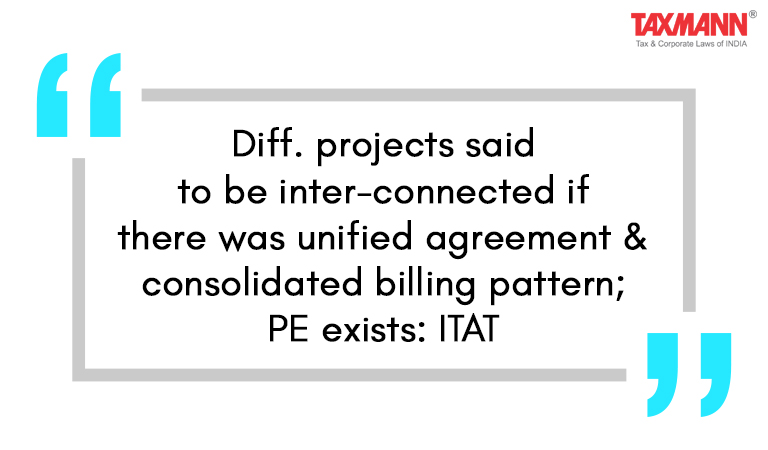Diff. projects said to be inter-connected if there was unified agreement & consolidated billing pattern; PE exists: ITAT
- Blog|News|International Tax|
- 2 Min Read
- By Taxmann
- |
- Last Updated on 19 August, 2021

Case details: Telenor ASA v. DCIT - [2021] 129 taxmann.com 198 (Delhi - Trib.)
Judiciary and Counsel Details
-
- Kul Bharat, Judicial Member and DR. BR.R Kumar, Accountant Member.
- Ajay Vohra, Sr. Adv. for the Appellant.
- Dr. Prabha Kant for the Respondent.
Facts of the Case
Assessee was a tax resident of Norway. It had entered into Business Service Agreement with Unitech Wireless (Tamil Nadu) India P. Ltd. As per the BSA, the assessee provided services under independent Service Order Forms (SOFs) to Unitech Wireless. Assessee treated its income as “fee for technical services” (FTS) and offered tax @10% on gross basis, relying on Article 13 of the DTAA between India and Norway.
However, the Assessing Officer (AO) held that assessee had a PE in India in terms of Article 5(2)(1) of the Treaty. Time spent by employees of the assessee in India, while rendering services to Unitech Wireless, exceeded the threshold provided in that Article 5. Thus, such income would be taxable as per Article 7 of the Treaty. DRP also upheld the order of AO.
Aggrieved-assessee filed the instant appeal before the Tribunal. It was contended that the various SOFs constitute separate projects & activities and cannot be treated as single consolidated activities. The duration of stay of its employees, with respect to the various projects undertaken by it, does not exceed six months per project. Thus, Article 5 of the treaty wasn’t attracted in its case.
ITAT Held
The Delhi Tribunal held that assessee raised bills on quarterly basis. Consolidated invoices were raised irrespective of the SOFs under which the services were rendered. The common billing and the common payments give rise to the conclusion that there was a single contract.
Further, on going through the sequence of activities, it can be concluded that the activities consist of the same and enter-connected projects. The activities of the assessee cannot be said that were unrelated to each other as none of the activities could stand in isolation from the other activity. No single activity can give rise to performance and achieving the purpose of the recipient.
The activities start with preparation, execution, and negotiation of the Global System for Mobile Communication (GSM) to devising the strategy development, preparation of IT solutions architect, benchmarking the same, recruiting the manpower for the purpose of implementation, and training them for various activities in relation to GSM role out to customers.
It was a clear commercial coherence between the activities as no single activity mentioned above doesn’t serve any purpose individually, when segregated. All these activities were different facet of one seamless function. The project as defined in the Article 5(2)(1) consists of bundle of inter-connected and interrelated services with the underlying theme of completion of projects. In the instant case, the implementation of one SOF leads to the other and it can be observed that they were well integrated, the outcome of one SOF becomes the inputs for the other SOF.
Thus, based on the unified agreement, consolidated billing pattern, the activities were found to be interrelated. Accordingly, the existence of the PE of the assessee was undeniable.
Disclaimer: The content/information published on the website is only for general information of the user and shall not be construed as legal advice. While the Taxmann has exercised reasonable efforts to ensure the veracity of information/content published, Taxmann shall be under no liability in any manner whatsoever for incorrect information, if any.

Taxmann Publications has a dedicated in-house Research & Editorial Team. This team consists of a team of Chartered Accountants, Company Secretaries, and Lawyers. This team works under the guidance and supervision of editor-in-chief Mr Rakesh Bhargava.
The Research and Editorial Team is responsible for developing reliable and accurate content for the readers. The team follows the six-sigma approach to achieve the benchmark of zero error in its publications and research platforms. The team ensures that the following publication guidelines are thoroughly followed while developing the content:
- The statutory material is obtained only from the authorized and reliable sources
- All the latest developments in the judicial and legislative fields are covered
- Prepare the analytical write-ups on current, controversial, and important issues to help the readers to understand the concept and its implications
- Every content published by Taxmann is complete, accurate and lucid
- All evidence-based statements are supported with proper reference to Section, Circular No., Notification No. or citations
- The golden rules of grammar, style and consistency are thoroughly followed
- Font and size that’s easy to read and remain consistent across all imprint and digital publications are applied





